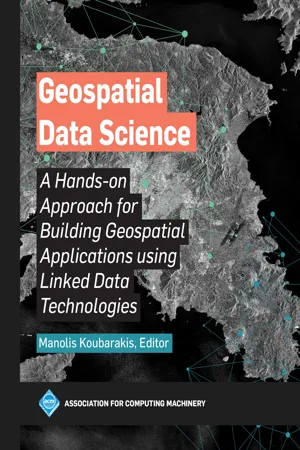
ACM Books
A Hands-on Approach for Building Geospatial Applications using Linked Data Technologies
- 364 pages
- English
- ePUB (mobile friendly)
- Available on iOS & Android
ACM Books
A Hands-on Approach for Building Geospatial Applications using Linked Data Technologies
About This Book
This introductory textbook teaches the simple development of geospatial applications based on the principles and software tools of geospatial data science. It introduces a new generation of geospatial technologies that have emerged from the development of the Semantic Web and the linked data paradigm, and shows how data scientists can use them to build environmental applications easily.
Geospatial data science is the science of collecting, organizing, analyzing, and visualizing geospatial data. Since around 2010, there has been extensive work in the area of geospatial data science using semantic technologies and linked data, from researchers in the areas of the Semantic Web, Geospatial Databases and Geoinformatics. The main results of this research have been the publication of the OGC standard GeoSPARQL and the implementation of a number of linked data tools supporting this standard. Up to now, there has been no textbook that enables someone to teach this material to undergraduate or graduate students.
The material of the book is developed in a tutorial style and it is appropriate for an introductory course on the subject. This can be an advanced undergraduate course or a graduate course offered by Computer Science or GIS faculty. It is a hands-on approach and every chapter contains exercises that help students master the material.
The book is accompanied by a Web site: https://ai.di.uoa.gr/geospatial-data-science-book/index.html where solutions to some of the exercises are given together with supplementary material such as datasets and code. Most of the material in the book has been tried in the "Knowledge Technologies" course taught by the first author in the Department of Informatics and Telecommunications of the National and Kapodistrian University of Athens since 2012.
Frequently asked questions
Information
Table of contents
- Cover
- Halftitle
- Title Page
- Copyright Page
- Dedication
- Contents
- Preface
- Chapter 1 Introduction
- Chapter 2 Geospatial Data Modeling
- Chapter 3 Legacy Geospatial Data Technologies
- Chapter 4 Ontologies and Linked Data
- Chapter 5 Geospatial Ontologies
- Chapter 6 Linked Geospatial Data
- Chapter 7 Querying Geospatial Data Expressed in RDF
- Chapter 8 Visualizing Linked Geospatial Data
- Chapter 9 Transforming Geospatial Data into RDF
- Chapter 10 Interlinking Geospatial Data Sources
- Chapter 11 Geospatial Ontology-based Data Access
- Chapter 12 Incomplete Geospatial Information
- Chapter 13 Geospatial RDF Stores
- Chapter 14 Geospatial Knowledge Graphs
- Chapter 15 Question Answering Engines for Geospatial Knowledge Graphs
- Chapter 16 Putting It All Together: A Data Science Pipeline for Linked Earth Observation Data
- Chapter 17 Conclusions
- Appendix A Prefixes
- Bibliography
- Authors’ Biographies
- Index